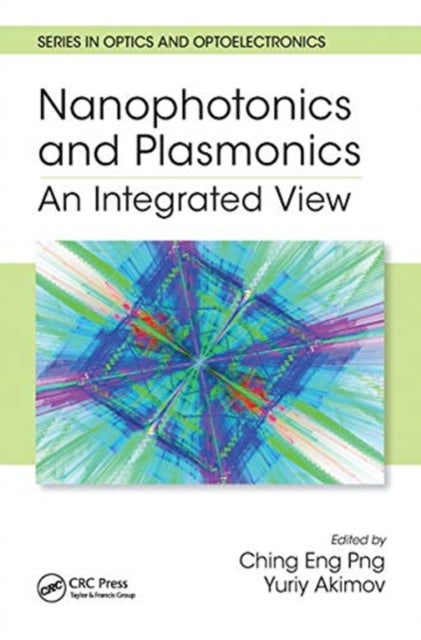Shulph Ink
Nanophotonics and Plasmonics: An Integrated View
Nanophotonics and Plasmonics: An Integrated View
💎 Earn 239 Points (£2.39) on this item.
- Condition: Brand new
- UK Delivery times: Usually arrives within 2 - 3 working days
- UK Shipping: Fee starts at £2.39. Subject to product weight & dimension
Bulk ordering. Want 15 or more copies? Get a personalised quote and bigger discounts. Learn more about bulk orders.
Couldn't load pickup availability
- More about Nanophotonics and Plasmonics: An Integrated View
The book Nanophotonics and Plasmonics: An Integrated View provides a comprehensive overview of nanophotonics and plasmonics, covering the use of dielectric, semiconductor, and metal nanostructures to manipulate light at the nanometer scale. It highlights similarities and advantages, and shows the common underlying physics, targets, and methodologies used for different materials. The goal is to provide a basis for developing a unified platform for both fields, with detailed theoretical background and main device applications.
Format: Paperback / softback
Length: 348 pages
Publication date: 31 March 2021
Publisher: Taylor & Francis Ltd
Nanophotonics and plasmonics are two fields that have gained significant attention in recent years due to their potential applications in various areas such as communication, imaging, and energy harvesting. Nanophotonics involves the manipulation of light at the nanometer scale using dielectric, semiconductor, and metal nanostructures, while plasmonics focuses on the manipulation of light at the nanometer scale using metallic nanostructures. This book provides a first integrated view of these two fields, covering the fundamentals, theoretical background, and device applications.
The book begins by introducing the basic principles of nanophotonics and plasmonics, including the principles of light propagation, absorption, and scattering. It then discusses the different types of nanostructures used in these fields, including nanowires, nanorods, nanotubes, and nanocrystals. The authors highlight the similarities and advantages of each type of nanostructure, as well as the common underlying physics, targets, and methodologies used for different materials.
One of the key advantages of nanophotonics and plasmonics is their ability to manipulate light at the nanometer scale. This allows for the development of smaller and more efficient devices, such as optical sensors, lasers, and solar cells. Nanophotonics has been used to develop optical communication systems that can transmit data at high speeds over long distances, while plasmonics has been used to develop optical imaging systems that can image objects at the nanometer scale.
However, there are also challenges associated with these fields. One of the main challenges is the fabrication of nanostructures. Nanostructures are typically small and delicate, and it can be difficult to control their properties and shape. This has led to the development of new fabrication techniques, such as lithography, self-assembly, and nanofabrication.
Another challenge is the integration of nanophotonics and plasmonics with other technologies. Nanophotonics and plasmonics can be integrated with other technologies such as electronics, photonics, and materials science to create new and innovative devices. However, this integration can be complex and requires a deep understanding of the underlying physics.
The book also showcases the main device applications of nanophotonics and plasmonics. These applications include optical communication systems, optical imaging systems, solar cells, and energy harvesting systems. The authors provide detailed descriptions of each application and discuss the challenges associated with each application.
In addition to the fundamentals and detailed theoretical background, the book showcases the main device applications. The authors provide detailed descriptions of each application and discuss the challenges associated with each application.
One of the key applications of nanophotonics is optical communication systems. Optical communication systems are used to transmit data over long distances. Nanophotonics has been used to develop optical communication systems that can transmit data at high speeds over long distances, such as fiber optic communication systems.
Nanophotonics has also been used to develop optical imaging systems. Optical imaging systems are used to image objects at the nanometer scale. Nanophotonics has been used to develop optical imaging systems that can image objects at the nanometer scale, such as confocal microscopy and scanning electron microscopy.
Solar cells are another key application of nanophotonics. Solar cells are used to convert sunlight into electricity. Nanophotonics has been used to develop solar cells that are more efficient than traditional solar cells.
Energy harvesting systems are another key application of nanophotonics. Energy harvesting systems are used to convert energy from the environment into electricity. Nanophotonics has been used to develop energy harvesting systems that are more efficient than traditional energy harvesting systems.
In conclusion, nanophotonics and plasmonics are two fields that have gained significant attention in recent years due to their potential applications in various areas such as communication, imaging, and energy harvesting. This book provides a first integrated view of these two fields, covering the fundamentals, theoretical background, and device applications. The book showcases the main device applications of nanophotonics and plasmonics, and discusses the challenges associated with these fields. By understanding the fundamentals and device applications of nanophotonics and plasmonics, we can develop new and innovative devices that can improve our lives and the world around us.
Weight: 667g
Dimension: 234 x 156 (mm)
ISBN-13: 9780367781989
This item can be found in:
UK and International shipping information
UK and International shipping information
UK Delivery and returns information:
- Delivery within 2 - 3 days when ordering in the UK.
- Shipping fee for UK customers from £2.39. Fully tracked shipping service available.
- Returns policy: Return within 30 days of receipt for full refund.
International deliveries:
Shulph Ink now ships to Australia, Belgium, Canada, France, Germany, Ireland, Italy, India, Luxembourg Saudi Arabia, Singapore, Spain, Netherlands, New Zealand, United Arab Emirates, United States of America.
- Delivery times: within 5 - 10 days for international orders.
- Shipping fee: charges vary for overseas orders. Only tracked services are available for most international orders. Some countries have untracked shipping options.
- Customs charges: If ordering to addresses outside the United Kingdom, you may or may not incur additional customs and duties fees during local delivery.


